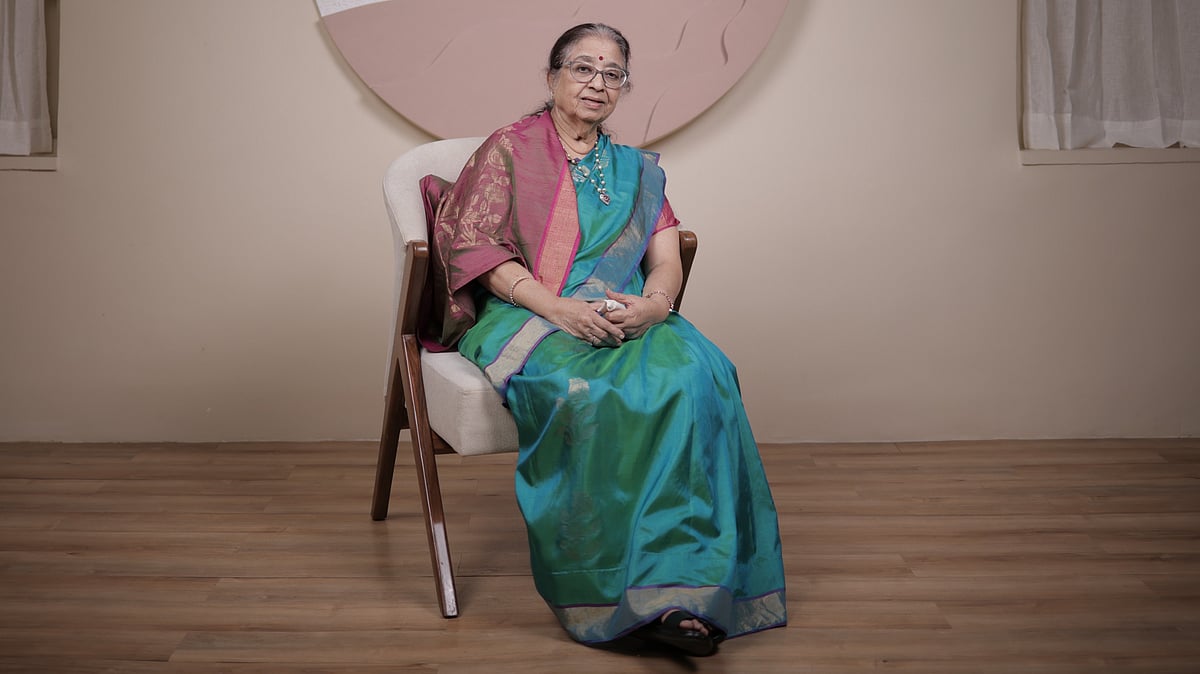Chanderi, the small town in the heart of India, Madhya Pradesh, is also the heartland of handloom weaving. The looms of this town provide a livelihood to many weavers like Saiful Islam, whose deft hands spin magic on yarn and create exquisite and intricate designs in pure silk, silk cotton, and Chanderi cotton fabrics, day in and day out.
The pandemic took a toll on the 17K odd weavers in Chanderi. Master weaver Islam also lost many artisans in his family and cluster, but all through, none of them stopped the loom ever. "I have been engaging these artisans in work and paying them Rs 500 per loom every week ever since the first lockdown, and mostly from my savings. I arrange the raw material while these weavers run the loom. Things had started looking up in January-February this year, and the business prospect took a hit in the second wave," says Islam.
Seven generations of Islam's family has been weaving Chanderi handloom, and through his venture Ruhi Chanderi Fabric, he has been able to streamline the process. He procures orders, distributes work among 40 weavers' families, and then sells the final products through many e-commerce outlets, including Bunavat, Nisha and Shefali, Sihali Jageer, etc, and with these small measures, Islam lights up hope for the handloom sector.

Master weaver Saiful Islam with actor Shraddha Kapoor |
Tough times
The life of a handloom weaver is synonymous with daily drudgery, with the entire family engaged in toiling hard for days at a stretch to produce a piece of handwoven fabric.
Avipsha, founder, Bunavat, recounts meeting two elderly weavers - Padma and her husband Hemanya - of the famous Ilkal sarees in Ilkal, North Karnataka, working together on a piece. She says, "The elderly couple took turns on the same loom. Hemanya would come in the morning and weave till noon while Padma completed her daily chores, and then she would replace him till evening while he went back home for lunch and rest. So, every saree they wove together carried such a beautiful story of love, compassion, skill, and struggle woven into one."
The handloom weaving is often a family affair everywhere, with the entire family of the weaver engaged in doing something or the other, either on the loom or off it, adds Islam.

Begumpur, Bengal | Pic courtesy: Bunavat
Sanjukta Dutta established Sanjukta’s Studios in Guwahati in 2014 to create customised pure lineage handcrafted Assam Silk Mekhela Chador. It has 13 factories, and over 100 looms working for the brand. "Every single Mekhela Chador is unique, customised and handcrafted by a select bunch of specialised artisans. The materials used are locally produced by rearing silkworms and getting cocoons of a particular lineage of worms found only in a single village in Assam. Each piece goes through a rigorous 45-day production cycle before it reaches the shelf," she says, on the rigours of producing a handloom product.
Over the years, handloom is slowly losing its sheen, but young weavers and entrepreneurial interventions by a few others have renewed interest among the weavers and consumers, in some measure. But the pandemic caught them off guard.
Highlighting the plight of artisans, Avipsha says, "Weavers and smaller craftpreneurs have been facing numerous challenges - cancelled orders, payments on hold, exhibitions stalled and piles of unsold inventory. Many families were forced to shut down looms and take up other day jobs to support families. Many weavers sold items at a loss to clear their inventory."

Anushka Sharma in Saiful Islam's creation |
Looming gloom
Apart from affecting the procurement and movement of raw materials and finished products and eventually their sales, the pandemic has deeply impacted consumer behaviour. "Work from Home, no social outings, restrictions on social gatherings, salary cuts, job losses, and the general sombre mood has disrupted the purchasing pattern of customers. Along with other factors, the change in consumer behaviour has affected the handloom industry and forced artisans and their families to migrate to other jobs," says Vijayalakshmi Nachiar, founder, Ethicus, India's first organic and sustainable fashion brand.
Down south in Venkatgiri town of Andhra Pradesh, artisan P Muni Raja and 25 weavers in his cluster used to weave 40 sarees a month and about 400 in a year before the pandemic struck. Zero sales and no exhibitions or shows over the last few months have left them in the throes of woes. "Covid-19 came as a bolt from the blue for the handloom weavers. There were hardly any buyers. The saddest part was that some of the weavers had to change their vocation to fend for themselves, and so the number of weavers in this town saw a drastic drop," adds Raja, a national awardee for his innovative weaves in 2003.

In the run-up to National Handloom Day on August 7, Raja was among many other artisans from across the country who the Ministry of Textiles celebrated as the 'Artisan of the Day' on its social media handles. Like Islam, he paid weavers from his pocket. "I incurred a loss of more than Rs 15 lakh in the past 18 months because there was no way I could let my weavers starve," he says.
Realising how difficult the lockdown must have been for the weaving communities, Bunavat stepped in to raise over Rs 1.5 lakh to support 192 weaver families with ration supplies last year. This year, it raised Rs 1.1 lakh for 31 families and provided Rs 1.25 lakh zero-interest loans to weavers. "We placed pre-orders of over Rs 2 lakh in many clusters of Madhya Pradesh and West Bengal during the pandemic to ensure the weavers had work and the looms kept running. We bought stock from almost all the clusters in varying quantities to ensure some funds reach them. We also took pre-bookings from customers even while logistics was on hold only to support our weaver communities," says Avipsha.
Letting the loom bloom
Nachiar says stocking raw materials, getting in-house artisans, and revamping Ethicus' online presence enabled them to work and stay afloat during the pandemic. "Regularly educating our artisans on the importance of wearing a mask, washing their hands and being safe has helped us work without much disruption. We have also ensured that all our artisans and their families have been vaccinated too," she adds.
In the early days of her entrepreneurial journey, Dutta had witnessed the miseries that a handloom artisan suffers. To increase hopes in the weavers to continue their age-old craft, thereby retaining skilled labour in the market, she knew that it was pertinent to take care of the handloom artisans. "I have managed to support over a hundred families of artisans with an all-inclusive benefit for education, medical needs, and lodging in addition to their salaries. The benefits are showing, and we are still able to make healthy profits. We are re-investing in getting more artisans back to the core while ensuring the welfare and well-being of their families so that all they have to bother about is their art," she says.
To honour the hard work that goes behind creating a piece of handloom, Ethicus, on the other hand, has pictures and names of artisans on tags of its products. "The weavers had tears in their eyes when they saw this. They said that they had never been honored in such a way. It was a heartwarming moment for them and us too," adds Nachiar.
Islam takes immense pride in following a fair wage system for the weavers. "If the labour cost of making a sari is Rs 2250, I might pay more, but never a penny less than the fixed amount to the weaver. There is no profiteering in between. The weavers are quite clued in the process, from procurement of orders to designing and sale," says Islam.
Offline to online
Gamusa weaver Rina Gogoi Saikia in Duliajan, Assam, who has been working on the loom for as long as she remembers, has been at the receiving end of the misery brought forth by the pandemic. She has witnessed some of the artistic and distinctive weavers, weaving styles and clothes and acquired knowledge in many aspects of traditional handloom over the years. "There has been a steep decline in the production and promotion of local handloom. The pandemic made the matter much worse. Weavers have lost the market channels, and the income generation is slowly degrading. Due to fewer market opportunities in nearby areas, weavers have to transport their products to faraway places, which ultimately adds to their expenses."
Saikia's son Rohit has been working with her since 2017. Together, they are trying to catch up with the online market dynamics; they sold a few pieces of her handcrafted Gamusa through social media during the pandemic and managed to clear a part of their stock.
"Last-mile weavers do not have direct access to markets. With everything moving online from retailers to customers, it became imperative for weavers to also look for prospective buyers (either businesses or consumers) online, which surely isn’t their core competency," says Avipsha.
In light of the pandemic, weavers and artisans like Raja, who are adept at selling wholesale and retail, found it challenging to adapt to the new normal. They have been facing significant challenges in accessing markets and unsold inventory. "With markets moving online, weavers and artisans must have a digital presence or have the ability to search retailers online who can procure their products. Digital empowerment of craftspeople is crucial in the current situation. Also, helping them create products aligned to market needs through proper skill training is another important aspect," says Avipsha. Bunavat conducted a digital skilling and photography training program with young weavers of Maheshwar in February 2020 and April 2021. "It helped the weavers increase sales by at least 15%," she says.

Reviving the art
Nachiar believes that conscious consumers who buy handwoven products can go a long way in reviving the sector. "This has to be enabled by the government through ads and public messages. The mindset of people has to change; they need to become more conscious of their choices. At the same time, artisans and people working in this space need to look at their products and evaluate them. Products have to evolve to survive and thrive."
Dutta couldn't agree more with her. "Innovative artistic attitude is the key aspect for the revival of any handlooms," she says.
As a brand working in the handloom space, Bunavat feels a need to constantly innovate and map the market needs to make handloom relevant for the urban populace. "We promote the simplest handwoven sarees like Dhonekhali Tants to Bobilli cotton, which are pocket friendly, and burst the myth that handlooms are expensive and encourage first-time handloom buyers to make a purchase," says Avipsha.
Dutta explains that initiatives are necessary to ensure a steady workstream and money flow and lure the younger generation. "We need to preserve the age-old handloom tradition, make weaving a sustainable career option and garner the trust of the younger generation to take the handloom tradition forward," she adds.
Keeping the younger generation of weavers motivated to stay in this space and keep the craft alive is a huge challenge. "Focused training programs, especially around designing, marketing, and digital literacy, are crucial at this time to keep them sustainably excited about these weaving traditions and encourage them to innovate," says Avipsha.
Perhaps, it is for the younger generation of weavers and buyers to take up the cudgels and keep the flame of handloom art burning bright so that my handloom becomes my pride as well.
(August 7 was National Handloom Day)














